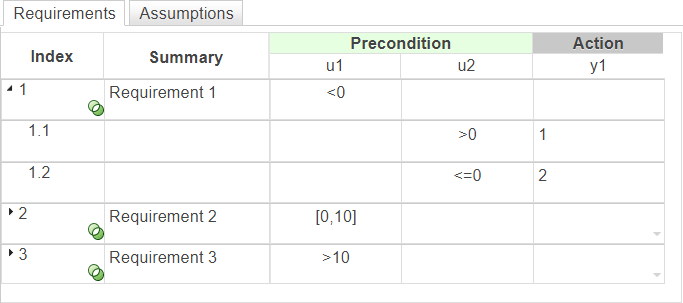创建互斥穷举需求
您可以使用互斥穷举需求来创建不重叠且完整的同级需求。当您运行仿真时,Requirements Table 模块会检查每个时间步中是否恰好有一个互斥穷举同级需求处于活动。如果在任何时间步中没有或有多个互斥穷举同级需求处于活动,则该模块将返回错误。您可以通过指定需求表的子评估来创建第一级层次结构的互斥穷举需求,或者通过指定父需求的子评估来创建互斥穷举子需求。有关需求层次结构和子评估的更多信息,请参阅 在 Requirements Table 模块中建立层次结构 和 在 Requirements Table 模块中指定子评估。
为第一级层次结构需求指定独占详尽评估
要创建互斥穷举第一级需求,请确保未选择某行,并且在表选项卡的行部分中,将计算设置为 Exclusive Exhaustive。排他性图标 ![]() 表示第一级层级需求是互斥穷举的。只有第一级层次的需求才是排他性的互斥穷举。较低级别的需求并不是互斥穷举的,而是独立评估的。
表示第一级层级需求是互斥穷举的。只有第一级层次的需求才是排他性的互斥穷举。较低级别的需求并不是互斥穷举的,而是独立评估的。
例如,在此表中,模块检查每个时间步中需求 1、2 或 3 中只有一个处于活动。

您可以通过设置 RequirementsTable 对象的 ChildEvaluation 属性以编程方式创建互斥穷举第一级需求。
指定对子需求的互斥穷举评估
为了使父需求的子需求互斥穷举,请选择父需求的行索引。然后,在表选项卡的行部分中,将计算设置为 Exclusive Exhaustive。排他性图标 ![]() 表示该需求是互斥穷举的。当您为父需求指定互斥穷举子需求评估时,只有父需求的直接子需求才会变为互斥穷举。较低级别的需求并不是互斥穷举的,而是独立评估的。
表示该需求是互斥穷举的。当您为父需求指定互斥穷举子需求评估时,只有父需求的直接子需求才会变为互斥穷举。较低级别的需求并不是互斥穷举的,而是独立评估的。
在此表中,需求 1 的子评估是互斥穷举的,而子需求 1.1、1.2 和 1.3 显示排他性图标。

要删除父需求的互斥穷举子评估,点击父需求行索引并将计算设置为 Independent。
您可以通过设置 RequirementRow 对象的 ChildEvaluation 属性以编程方式创建互斥穷举子需求。
验证互斥穷举需求
如果您有 Simulink® Design Verifier™,您可以在运行仿真之前通过分析表格中的排他性问题来验证您的互斥穷举需求。要分析该模块,请在表选项卡中点击分析表。有关分析和排他性问题的更多信息,请参阅检测 Requirements Table 模块中的排他性问题。
另请参阅
RequirementRow | RequirementsTable